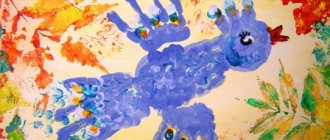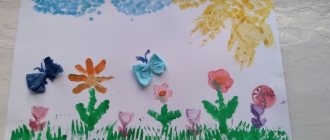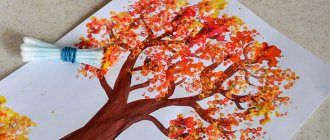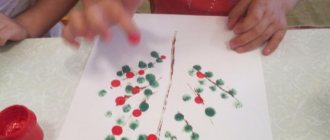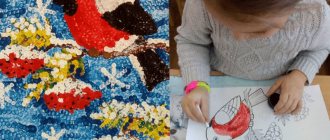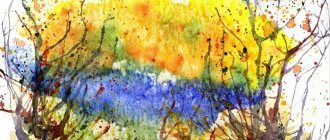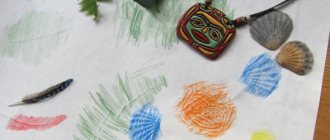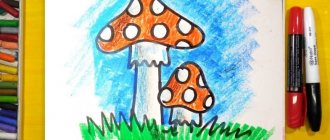Art is a boundless ocean or endless space. Being dualistic, it awakens in a person the desire to comprehend the unity of form and formlessness, beauty and conventionality of forms, vision of the essence, enjoying beauty. Contemplating works of art, even a little person, a newborn, learns to join this boundless world and discover his creative abilities.
The expression of world masterpieces resonates with the vibrations of the strings of the human soul. Japanese scientist Masaru Ibuka, who founded the Sony company, in his book on the early development of children, “After Three It’s Too Late,” describes in detail the need to instill in a child from birth the ability to admire beauty.
Drawing at preschool educational institution
How to get your child interested in drawing
Absolutely all children, learning about the world around them, do this through the act of creativity. The psyche of a baby from birth is like a blank slate, but personality and temperament are already innate. Therefore, parents need to try to understand the individuality of their child and contribute as much as possible to the disclosure of his inner potential without unnecessary pressure and neglect.
On a note! To do this, it is not at all necessary to compete with each other in the number of developmental activities, courses and clubs, but to provide the child with space and material for creativity as early as possible, studying with him.
Where to begin:
- Starting from six to seven months, when the baby has already begun to sit confidently, you can give him an album and finger paints, soft wax crayons, modeling dough, and so on. Water coloring pages are also suitable.
- Bright, but not acidic colors and ease of use will immediately attract the little creator for at least a few minutes, or maybe even an hour. This will be enough for daily activities; they also contribute to the development of concentration and perseverance. In addition to special techniques with various cards and bags, each mother can independently find a lot of ways to expand the boundaries of perception and encourage her baby to be creative with the help of available tools, helping and supporting. Co-creation is the basis for closer, trusting relationships in the future.
- Creator's Kit. The simultaneous perception of color and shape, the skills of holding a pencil or brush in your hand, drawing, sculpting - all this creates new neural connections, and regular repetitions strengthen them.
- It is ideal to interest a child by personal example, when one of the parents, an older brother or sister draws.
- Collective creativity that develops drawing in children in kindergarten.
- However, if a child shows no interest in drawing at all, but prefers more active actions, then there is no need to force him, it will only have the opposite effect. Such children should be periodically offered drawing unobtrusively.
Conditions and means
Important! All creative materials for children under three years of age should be as safe and non-toxic as possible. They need to be bought in special stores from responsible manufacturers, or made with your own hands from food products (flour, water, salt, fruit juices, etc. There are a lot of recipes on the Internet!)
Such classes are held at home in a comfortable environment under the supervision of adults. During teething, you can exclude them, or use special products that relieve itching of the gums so that the child does not eat paints and crayons.
What does fine art give and develop in a preschooler?
At the age of three, there is a leap in brain development, as well as the autonomy of the little person’s consciousness from his parents. During this period, it is very important to promote independence and creativity. At the same time, a crisis at the age of three is possible, when a child rebels and protests against literally everything. Engaging in creative activities will help you get through this period easier. And in the future it contributes to the formation of a comprehensively developed personality.
Middle group project “My Family”: GCD lesson plan
Methods and techniques for teaching drawing
Elvera Batyrova
Methods and techniques for teaching drawing
Consultation on the topic:
Methods and techniques for teaching drawing
Passing the material Methods and techniques of teaching
Early development group. In the first half of the year, children learn, coordinating hand movements, to purposefully draw lines in the form of arcs , lines of a spiral nature.
In the second half of the year, children learn the simplest images, outlining certain didactic tasks, learn to rhythmically apply strokes of bright color on paper. Showing how to use pencils and paints
Passive movements - the child does not act independently, but with the help of the teacher
Reading nursery rhyme poems and songs in the classroom is the most important methodological technique - it increases the positive, emotional attitude of children to the lesson, contributes to the formation of a figurative idea of what is being depicted
Junior group. In the first quarter, children must master images of objects , using the ability to draw straight and rounded lines.
In the second quarter, consolidating the skills of depicting various objects consisting of combinations of lines (trees, Christmas trees, a checkered scarf)
In the third quarter, learning in a new formative movement aimed at conveying rectangular objects .
In the fourth quarter, children draw objects of familiar shapes, mainly drawing by design . drawing classes are actively used
information-receptive method . Especially useful before class
an effective way to get to know the shape of an object: children trace the shape with their hand,
play with flags, balls, balls, feel their outlines. This
examination of an object creates a more complete picture of it.
Also effective is the technique of examining an object by moving your hand along the contour and showing this movement in the air. Direct demonstration of the image method is used only if this form is encountered for the first time.
Middle group. In the first quarter, children consolidate the knowledge acquired earlier and learn to draw oval and round objects, as well as distinguish between them.
In the second quarter, children learn to distinguish and draw round , oval, triangular, and rectangular shapes. Develop aesthetic perception and taste.
painting classes are introduced in the third quarter . The elements of the pattern are studied.
In the fourth quarter, new material is not provided; previously acquired knowledge is consolidated and used freely. In the middle group, to better reproduce the image a visual method ; a picture or drawing by the teacher can be used. Demonstration of drawing in the middle group continues to occupy a significant place in teaching in those classes where new program material is given: the sequence of depicting parts of an object, the concept of rhythm, pattern, etc.
Senior group. In the first quarter, children consolidate the knowledge, skills and abilities acquired earlier. Next, in the older group, children draw a person
Collective work will be introduced in the second quarter
In the third quarter, along with depicting objects, children learn to draw animals and improve the depiction of the human figure.
In the fourth quarter, children learn to independently reflect impressions received from the environment. The method of showing a child how to draw is used widely, but only in relation to technical problems: how to hatch, how to paint, how to hold a brush and arm, etc.
Preparatory group. The first quarter provides for both new knowledge and skills and consolidation of previously acquired ones. Activities based on children’s ideas and illustrating fairy tales are also used.
In the second quarter, decorative drawing ; it is based mainly on decorating things made of paper, cardboard, and sculpted from clay.
In the third quarter, problems of an aesthetic nature are solved, children develop a sense of color and composition, and learn to expressively convey a plot and images. A visual method is to refer to a sample; study of the image object, showing the method of action; problematic issues and situations; creation of drawings based on the wide use of artistic words, game techniques, surprise moments, etc.
Methods and techniques for teaching drawing in all age groups.
FIRST JUNIOR GROUP
The most accessible type of art activity for children of this age is drawing . It is important to arouse interest in activities with pencils, paints, and felt-tip pens. Children should be drawn to the fact that a pencil, brush, or felt-tip pen will leave a mark on the paper if you run the sharpened end of a pencil or brush over it. It is advisable for the teacher, together with the child, to examine the results of actions with a pencil, brush, felt-tip pen, draw along the lines drawn on the paper with the fingers of one or the other hand, and ask what it is, what it looks like. At the same time, an adult should be patient and not insist on a quick answer. It is necessary for the child to gradually comprehend all this on his own. Children's statements about who drew should be encouraged without questioning. It is important to encourage children to complement the drawn and named image by asking questions like “Where is the fish’s tail?”
.
This will cause the child’s thoughts to work, the desire to give the drawing a resemblance to the object , to complement the image with details known to him. It is necessary to encourage children to consciously repeat previously obtained strokes and lines, which will lead to the conscious creation of an image. As children master drawing with pencils, you can give children paints and a brush.
Children should be encouraged to draw a variety of objects that surround them and attract attention while playing, observing while walking, looking at them, or tracing the outline of an object with their hands. It is advisable to draw with sticks on the ground , on the snow, or with chalk on a blackboard, encouraging children to act with one hand or the other. Drawing should be free, that is, you should not rush to teach children to depict objects of a certain shape . It has been noticed that children quickly form stereotypical actions and develop the habit of drawing only these objects and only in the way the teacher showed them. This narrows the subject matter of the images a child can create; as a result, even when children have the opportunity to draw freely , they will repeat what they learned earlier. A completely different picture emerges when children, from the very beginning, have the opportunity to freely reflect in the drawing what they want: the content of the drawings becomes more varied and interesting. Children depict such objects (a car, the sun, a doll, a bird, a fish, a hare, etc.), which, as a rule, do not work with the traditional method (when children are asked to draw lines and objects of a certain shape.
To successfully master drawing , it is important to develop the sensory foundations of visual activity: perception of objects of different shapes (visual, tactile, kinesthetic, colors, starting with contrasting colors (red, blue, green, black)
and gradually adding other
(without limiting the number)
colors, without requiring children to memorize the names of a large number of them, but the teacher himself must name them. This will enable children to recognize and remember more colors.
One of the main tasks of the teacher is to teach children to hold a pencil, brush, or felt-tip pen correctly: with three fingers, not very close to the sharpened end or nap, without squeezing them tightly with your fingers. For a child, this task is perceived as personally significant for him: a child of this age wants to learn everything is right to make it beautiful.
SECOND JUNIOR GROUP
Children of this age need to develop the ability to listen to the teacher, create an image given by him or invented by themselves, evaluate the resulting result, and enjoy it.
To improve visual skills, you should continue to develop perception: learn to isolate an object from the environment, trace it with your hands (either one or the other)
along the contour or clasp it with your hands to feel the volume
(this will help you understand the shape of the object and convey it in the image)
.
In the process of perceiving objects , the teacher encourages children to identify and name their shape (round, square, triangular, color; teaches them to distinguish and name at least five to six colors. As a result, children have a desire to choose an object of a certain shape, color, etc. should encourage the addition of a story to the created image, the desire to hear an adult evaluate their work, and show interest in the drawings of other children.At
this age, under the guidance of a teacher, children master the process of depicting objects of a linear nature (colored sticks, strings, paths consisting of a combination of lines (ladder, fence, tree, herringbone, as well as objects of round , rectangular, triangular shape.To do this, you need to teach children formative movements in drawing , for which it is very important to include the movement of the hand along the contour of the object when perceiving it, show and explain to children that with one movement you can draw an object or all its parts that have the same shape.This is how children are led to mastering generalized methods of representation.
Children of this age are taught to draw objects that have one part (they start with them)
or several parts.
The objects offered to children for depiction may be different. The teacher can present them, children can choose them themselves at will. This increases their interest and desire to take up drawing . Interest in drawing by the inclusion of fairy-tale images (bun, turnip, creation of game incentives. In classes, children should be encouraged to create several images in order to more easily remember drawing and then act more freely and confidently.
As a result of repeated images of the same and different objects The baby's hand becomes more and more skillful, confident and free, which allows him to create more complex images.
Successful mastery of artistic activities is impossible without the development of fine muscles of the fingers. Children need to be taught to hold a pencil and brush correctly, without straining their muscles, without squeezing their fingers, and to move their hands with a pencil and brush easily and freely; use all materials correctly and carefully when painting (learn to put paint on a brush, dipping it into the paint with all the bristles, remove an extra drop by lightly touching the edge of the jar with the bristles of the brush so that the drop does not fall on the paper and spoil the drawing).
Children of the fourth year of life must be taught to sit correctly, that is, upright, without bending too much over a sheet of paper, without resting their chest on the edge of the table (so that their vision does not deteriorate, breathing is not difficult, movement is not constrained, to hold a pencil and brush correctly: between the large and with the middle finger, holding it on top with the index finger, without squeezing the fingers too much, not too close to the sharpened end.
In the process of drawing, children 's activities must be accompanied by nursery rhymes, songs, riddles, and music. This will help develop their emotional responsiveness when perceiving pictures and illustrations. Children's attention must be paid to expressive means.
MIDDLE GROUP
Children of the fifth year of life should develop aesthetic perception, aesthetic figurative ideas, imagination, artistic and creative abilities, the ability to examine objects (including with hand movements in shape, name the shape, color (and its shades, size (as an object as a whole, and parts)
.
In one lesson, it is advisable to offer to draw not one , but several objects of the same shape . By depicting the same object several times, children involuntarily change their size and position in space and at the same time gain confidence and freedom of movement, which contributes to the manifestation of creativity. Techniques for carefully painting over a drawing with paints and pencils should be demonstrated. To do this, you can use not only children's drawings, but also special albums in which the child is faced with the following tasks - to complete the drawing draw something himself .
To learn how to paint beautifully, a child must understand: the movements of the pencil and brush cannot be random, the lines should be drawn in one direction - from top to bottom, from left to right, or obliquely. Subjects for drawing should be offered only taking into account the children’s impressions (what interesting things they saw, what they were read, what they were told, what cartoons they watched, etc.). You can invite them to draw what they themselves want (by design)
.In this case, children’s attention should be paid to the location of the images on a sheet of paper: below - a strip of earth, grass, snow, water, on the entire surface of the sheet - a forest clearing, sea, snow field, etc.
Children of the fifth year of life must be taught to perform all images diligently, carefully, to finish what they start, and to be happy with the result.
Children must continue to be taught how to hold a pencil and brush correctly, and how to use paints and pencils correctly (do not press hard on the pencil, but increase the pressure only to get a brighter shade).
SENIOR GROUP
The visual activity of 5-year-old children is becoming increasingly conscious and intentional. They begin to develop an interest in this activity. The child’s sensory experience is enriched, the ability to analyze perceived objects, compare them with each other, and establish similarities and differences develops. Children can already be taught to convey in an image not only the basic properties of objects , but also characteristic details, the ratio of parts in size relative to each other. It is necessary to learn this in order to learn how to depict characters and plots of fairy tales, pictures of nature, various buildings, animals, etc. In the process of perceiving objects and phenomena, children should pay attention to the fact that objects can be located differently on a plane and can change position . An adult must teach the child to detail everything perceived, including movements, and to pay attention to the position of parts of an object in space. To create expressive images, you need to continue to develop your perception of color. The development of a sense of color is facilitated by decorative drawing , images of flowers, fairy-tale birds, palaces, etc. In the older group, children’s attention should be paid to the fact that the position of the sheet of paper on which they create the drawing should correspond to the proportions of the depicted object: if the object is tall, the sheet of paper is better position it vertically, and if it is elongated, then the sheet should be positioned horizontally. This is the only way the drawing will look beautiful. By placing an image on a sheet of paper, children master the simplest compositional skills: they can already place images in one plane (on a strip at the bottom of the sheet, but it is much more difficult, but also more beautiful, to arrange images across the entire sheet of paper in two or three plans, conveying perspective. So that children have learned to quite freely depict any objects and phenomena that interest them in a drawing, they need to be introduced to different drawing , different visual materials.Children of the older group, when creating images, use previously acquired various skills to draw with a brush : wide lines - with the whole bristle, thin lines - with the end of the brush, strokes - by applying the entire bristle of the brush. Such techniques can be used both in subject and decorative drawing . It is important for children to develop such qualities of drawing movements as unity (continuous movement when drawing lines , then they turn out smooth, rhythmicity (uniform movement when drawing the same elements of the pattern, when painting over images, etc.).
PREPARATORY SCHOOL GROUP
Children of the seventh year of life in drawing classes depict objects , scenes, landscapes, and create decorative compositions. When teaching the transfer of a plot, the teacher draws the children’s attention to the location of objects in space in relation to each other (which is closer, what is further, the blocking of one object by another, the ratio of objects in size , color, etc.
In the preparatory group for school, teaching children technical and visual skills and abilities, on which the quality of visual images depends, as well as a positive emotional attitude towards drawing remain important. Children are reinforced with previously learned methods of depiction, continue to develop the ability to freely use a pencil when performing a linear drawing, are taught smooth turns of the hand when drawing rounded lines , curls in different directions, are taught to move the whole hand when drawing long lines , large shapes, using only fingers - when drawing small shapes and small details, short lines, strokes, grass (Khokhloma, Ozhivok (Gorodets)
and etc.
The teacher teaches children to notice the beauty of the created image, i.e. shape, smoothness, unity, thinness, elegance of lines, rhythmic arrangement of lines and spots, uniform shading of the picture, smooth transitions of color shades resulting from uniform shading and correct regulation of pressure on the pencil.
Preparing for a drawing lesson in kindergarten
It is carried out by a teacher or educator, and from the age of five - together with children. Drawing in kindergarten is a full-fledged lesson in collective creativity.
On a note! Properly organized, collective classes also develop discipline and accuracy in children.
Algorithm of actions:
- Select a topic. For example, seasons (spring, summer, autumn, winter) or still life.
- Choose drawing techniques and techniques in kindergarten.
- Choose one of the types of traditional and non-traditional drawing in a preschool educational institution.
- According to the topic, you need to select a nature and a sample drawing.
- Prepare sheets of paper or their alternative, 5-10 pieces for each child. Sign the first and first letter of the last name in the upper left corner on the reverse side.
- Preparing watercolor or gouache - mix each color a little with water.
- Sharpening pencils.
- Immediately before class, you need to pour water into sippy cups.
Fine arts classes at preschool educational institutions
Types of traditional and non-traditional drawing for preschoolers in Preschool Educational Institutions
Traditional drawing techniques include:
- drawing with a simple pencil,
- colored pencils,
- felt-tip pens,
- gouache,
- using a stencil,
- wax crayons.
Today you can find or invent an endless variety of unconventional drawing techniques, their originality and attractiveness lie in unexpected ways of using a wide variety of materials.
Non-traditional techniques:
- Finger painting. To do this, use special finger paints or regular gouache.
- They also use gouache to paint with palms. To do this, you need large-format paper; it is possible to create a general picture with a whole group of children, or decoratively decorate the walls of the kindergarten.
- Creating a picture from colored or colorless sand.
- Intuitive drawing for children is another way to learn fine arts. In this case, the child is invited to choose or come up with a theme and drawing technique, offering him a choice of various materials.
Handouts needed for the lesson.
- Base: Whatman paper, cardboard, canvas, wooden planks.
- Materials: watercolor, gouache, soft plasticine, glitter, pencils, pens and felt-tip pens.
- Additionally: brushes (cotton swabs), erasers, palettes, cotton pads, scissors and glue for applique, etc.
Unconventional techniques
“Methodology for conducting classes in visual arts in the middle group (drawing)
“Methodology for conducting classes in visual arts
in the middle group" (drawing).
Educator of the Municipal Preschool Educational Institution “DS No. 7”, Blagodarny, Stavropol Territory Radchenko N.I. (from work experience).
Fine creativity is a children’s activity that is aimed at the aesthetic development of the world through visual arts.
new art. The basis of the artistic image is the “three pillars” - emotionality, interest, activity (E.A. Flerina).
A child is a creator by nature; all children see the world around them in their own way. Therefore, as a teacher, I need to teach children to boldly and freely use methods of creating an image, to help them develop a creative personality. What is intrinsically valuable is not the final product - a drawing, but the development of personality: the formation of self-confidence in one’s abilities, self-expression in creative work, purposefulness of activity.
Fine arts classes require pedagogically thoughtful equipment. My group has everything necessary for drawing - this is: a board, an easel, stands; tools: colored pencils, simple pencils, felt-tip pens, watercolor paints, gouache, brushes of two sizes, crayons, wax candles, sponge, cotton swabs, sippy cups, fabric napkins.
The more diverse I create the conditions in which visual activity takes place, the content, methods and techniques of working with children, as well as the materials with which children act, the more intensely children’s artistic abilities will develop.
The content and methods of conducting visual arts classes are aimed primarily at developing creativity in children. To do this, I use artistic expression, music, and creating an emotionally positive mood in children.
To implement the tasks of artistic and aesthetic development of children in my group, I use the following methods and techniques:
- play as the main activity of children of middle preschool age;
— visibility as the leading pedagogical method;
- method of aesthetic persuasion and aesthetic choice;
— traditional methods of pedagogy: dialogue, guessing riddles, reading fiction;
— didactic games, exercises, game situations, finger games (development of fine motor skills);
— design of exhibitions of children's creativity;
— method of physical activity (physical training minutes, finger exercises, dynamic pauses);
- listening to a piece of music;
— co-creation method (with a teacher or peer);
— use of non-traditional techniques and materials.
Unconventional drawing gives children many positive emotions. Having learned to express his feelings on paper, the child overcomes shyness and fear that nothing will work out. He is confident that it will work out, and it will turn out beautifully.
Individual approach and team work with children
Each child is instilled with the ability to feel a balance between collective activities with a teacher and the manifestation of their own individuality. The whole group receives a given topic, but everyone completes this task in their own way.
Conducting GCD on drawing on a chosen topic
- A selection of demonstration materials for the conversation (photos and drawings) form the basis of the visual aid for the lesson. Such pictures should be selected taking into account the age of the children. The image should be clear, three-dimensional, moderately bright, understandable for children, and not difficult to reproduce.
- Music and poetry appropriate to the topic of the lesson will help create a favorable background and creative atmosphere. They are also selected taking into account age characteristics. The positive influence of classical instrumental music, such as Bach or Beethoven, has been proven. Thematic children's songs about the depicted object are also perfect for a subject image.
- The lesson notes on drawing in the chosen technique for different age groups are prepared by the teacher in advance.
Mathematical notes of GCD in preparatory groups for Federal State Educational Standards
| Age group | Subject | Method and technique | Materials |
| 2-3 years, junior group | Apple | Dot drawing with a cotton swab. | Watercolor or gouache, cotton swabs, thick paper or cardboard with the outline of an apple. A jar of water, 3/4 full. |
| 3-4 years old, second youngest group. | Blooming spring tree | Graphics with colored pencils. | Set of colored pencils: pink, green, brown. Paper or cardboard. |
| 4-5 years old, middle group. | Autumn kindergarten. | Watercolor | A set of watercolor paints 10-12 colors, paper or cardboard, 2-3 small or medium sized squirrel brushes, a jar of water. |
| 5-6 years old, preparatory group | Undersea world | Application. Using stencils, drawings are drawn onto paper with a simple pencil, then they are cut out and pasted onto a background sheet. | Base - turquoise colored cardboard, PVA glue, hard glue brush, glass of water, a set of colored paper or cardboard of different colors, scissors, stencils (clams, shells, starfish, fish, octopuses, etc.), a simple pencil . |
Album “Options for non-traditional drawing techniques with children 4-5 years old
State budgetary preschool educational institution kindergarten No. 43, Kolpinsky district of St. Petersburg
Options for non-traditional drawing techniques with children 4-5 years old
Prepared by the teacher:
Gurina. A.A.
St. Petersburg, Kolpino
2020
Finger painting (fingergraphy)
Tactile sensations are, along with visual impressions, the leading way of understanding objects and phenomena around us. Therefore, special attention is paid to fingergraphy in kindergarten. But if in the younger groups children made dotted strokes, for example, painted peas on an umbrella, then in the middle group the children learn to draw lines, spots of different sizes, strokes, and also paint over certain elements of the drawing.
At the beginning of the year, children in the middle group repeat making dots with their fingers and train the skill of making round elements
In the middle group, the practice of finger drawing according to a pattern is introduced. The teacher tells, shows and hangs up an algorithm of actions on the board, how to draw an animal or a person using prints and dots-squiggles made with a pencil.
Schemes of step-by-step finger painting are presented in the book by I. Molnar “Imprint, dot, stroke. We paint with our fingers."
For fingerprinting, gouache is usually used, since it does not require dilution with water, is thick and produces bright shades. However, you can also use special hypoallergenic paints for finger painting, as well as watercolors. When working with the latter, before dipping your finger into the paint, you need to moisten it with water or drop some water into a container with watercolors.
Finger painting technique
The sequence of work in the fingergraphy technique is as follows:
- Dip your finger into the paint can.
- Using each finger we pick up paints of different shades. Remove excess with a damp cloth.
- Using your fingertips, apply the design to the sheet.
- After finishing work, wash your hands with soap.
In addition to berries and leaves, kids can also use their fingers to draw lines to depict branches.
Palm painting
As with finger painting, palm painting involves creating an imprint and adding to it using brushes. In the middle group, the imprint becomes the basis for creating various objects: birds, foliage, fish, etc. In addition, with your palms you can create elements such as leaves on trees, flowers in a vase, hedgehog needles, etc.
Palm drawing technique
For palm painting, the drawing algorithm will be as follows:
1. Place your palm in the saucer with paint. In the second semester, children learn to create multi-colored prints with one hand, so the paint will be applied with a brush held in their free hand. The skill of such multi-colored prints is developed in lessons on the topic “Bullfinch”, “Butterfly”, etc.
2. Press your palm firmly against the sheet, if necessary, slightly turn it in a circle, horizontally or vertically.
3.After finishing work, wash your hands with soap.
Drawing birds with their palms, the children add details made with a brush - beak, legs
Poking drawing
This technique is indispensable when creating “fluffy” or “spiky” images. Needles on a hedgehog, fur on a kitten, Christmas trees, dandelions - all these images acquire a special flavor thanks to the poking technique.
Poking technique
To create a poke:
- Place a dry brush with stiff bristles into a jar of gouache.
- Holding the brush vertically, we make a sharp blow to the paper.
- Rinse the brush and blot with a napkin.
The poke can only be done with a dry or semi-dry brush.
Toothbrush painting technique
To obtain voluminous, multi-layered designs, a toothbrush is used. Having collected the paint, we brush it across the sheet, focusing on the design.
In the middle group, drawing with a toothbrush is usually combined with the use of the poking method, appliqué or drawing with cotton swabs.
Toothbrush drawings in the middle group are usually made on a colored background
Monotype
This unconventional technique involves creating a picture by imprinting part of the design on the blank half of a folded sheet. At the age of 4–5, through monotype, children begin to master landscapes, which they will work with in older groups, train the ability to find the middle of an object, and develop the skill of seeing symmetry.
At the same time, not only symmetrical, but also paired objects are created in this way. To do this, a whole image is drawn on one half of the sheet, which is also completely printed on the second side.
Monotype technique
To create a monotype image:
- We bend the sheet in the middle - vertically or horizontally, depending on the location of the depicted object.
- Unbend and draw a picture on one half.
- We bend the sheet again and iron it with our hands.
- We expand and supplement the resulting image with the necessary elements. For example, let’s make a blue background for a river in which a forest is displayed.
In the drawing of a forest reflected in a lake, after unfolding the sheet, children draw a green strip of grass.
Spray
The essence of the technique is that kids pick up paint with a brush or comb, and, pointing it at the sheet, run a pencil along the bristles, thus painting the space of the drawing.
To create a one-color image from several elements, stencils are applied simultaneously
In the middle group, children become familiar with the concepts of foreground and background. For this, the multilayer spray method, which involves the use of stencils, will be an indispensable assistant.
Methodology for working with multi-layer spraying
To make a multi-layer spray:
- We attach the stencil to the sheet using paper clips.
- Take the paint with a brush.
- Let's spray.
- Apply another stencil.
- Spray a different color.
- We remove the stencils - the image turned out to be voluminous and multifaceted.
For multi-layer spraying, you can use stencils of the same image, but of different sizes, then you will get a flickering effect
Scratch
The technique involves scratching image lines on a paper substrate coated with paint according to a pattern previously applied with wax crayons.
Grattage technique
The procedure for creating a grattage drawing will be as follows:
- Color the drawing with wax crayons.
- Fill the surface of the sheet with black paint or ink.
- Leave to dry.
- Using a stick with a sharp end (for example, a wooden kebab skewer), we scratch the lines to reveal the design.
Drawing through gauze
Drawing through wet gauze does not require the use of unusual tools; the picture is created with a brush and paints.
Technique for drawing through gauze
To create a drawing using the original technique:
- We moisten the sheet with pieces of wet cotton wool or cotton pads.
- Place gauze on the paper and straighten it well.
- We create the drawing as usual.
- Let it dry, remove the gauze - the image becomes textured.
When painting through gauze, you need to apply the paint generously, as some of the “color” will disappear after removing the fabric.
Drawing with glue and semolina
We mark the indicated contours of the drawing with glue, pour in semolina and press it on top with a clean sheet. Remove the top sheet and shake off the remaining cereal. The elements are filled in one by one.
In the middle group, with this type of drawing, kids practice the ability to outline a stencil and apply glue exactly within the boundaries of the image.
The substrate for drawing semolina should be colored, since the grain will be invisible against a white background.
Wax painting
In the middle group, kids draw lines, spots and simple geometric shapes with a candle.
Wax painting technique
To create a candle design:
- We draw the outlines of the design on a white sheet with a candle.
- Paint the sheet with any colors.
- The wax lines remain unpainted and appear on the substrate.
Drawing with a wax candle is usually used in winter-themed lessons.
A variation of this technique is drawing with wax crayons. The process technology will be the same, but the wax pencils are multi-colored, so the drawings after filling with paint will be brighter.
For painting with wax, it is better to take watercolor paper, since children may not calculate the degree of moisture in the brush, and the sheet may break through.
Blotography
The essence of the technique is to obtain pictures based on spots and blots. Spots can either be used to decorate a design as intended, or can be used as a basis for an image in a traditional style.
Blotography technique
To create blots:
- Dip the wet brush into the paint.
- Make a stain or place a drop.
- Blow from a cocktail straw onto the paint, blowing it in the desired direction.
In the middle group, kids learn to inflate thin elements from a spot, for example, tree branches
Drawing with foam rubber
To highlight the texture of the depicted object - clusters of flowers, curly clouds - the method of applying paint with foam rubber (or a piece of sponge) is used. To prevent the sponge from getting your hands dirty, it is clamped with a clothespin that acts as a handle.
Stamping technique using natural materials
A whole vegetable (onion, corn, potato, cucumber, etc.) or fruit, berry (apple, lemon, feijoa, etc.), cut in half, flowers (daisies), shells, is painted and an imprint is created on paper. This technique is convenient for drawing cross-sections of fruits and vegetables. For example, to create the composition “Grandma’s Compote,” kids draw the outlines of a pan with a pencil, and depict fruits with stamps.
Algorithmic schemes in drawing animals by preschool children
Relevance
“
Visual and didactic aid” has a developmental, educational and educational value. It can be used in almost any type of educational activities and children's play activities. The meaning of visual activity lies in the ability to convey the surrounding reality with the help of visual materials and means. Children have difficulty drawing animals and conveying their movement.
Methodological apparatus
Object of study:
teaching preschoolers to draw animals.
Subject of research:
development of a visual didactic aid for teaching preschool children how to draw animals.
Purpose of the study:
to develop a visual didactic guide for teaching preschool children to draw animals.
Objectives of the study:
- to determine the types of visual aids used in teaching preschool children to draw animals;
— develop a long-term work plan for teaching preschool children how to draw animals;
- create step-by-step diagrams for drawing animals with children in preschool age;
— develop tasks for individual work with preschool children on learning to draw animals.
Research methods:
theoretical analysis of scientific literature.
Main part
Researcher B.G. Meshcheryakov defined the concept of children's productive activity as the process of obtaining a product that has certain specified qualities.
S.V. Pogodina points out that productive activity has a number of structural components:
Productive activity
motive
goals
actions
Main part
According to T.S. Komarova, mastery of visual skills, including technical ones, is closely related to the development of the action of perception and presentation of objects.
Sakulina N.P. shows that to create a drawing, it is necessary to have, on the one hand, clear ideas about those objects and their qualities that should be drawn, on the other hand, the ability to express these ideas in graphic form on the plane of a sheet of paper, to subordinate the movement of the hand to the task of imagination.
- Ability to use pencil and brush fluently
- ability to regulate movements in terms of strength and tempo
- the ability to depict in a drawing the main features and properties of an object
According to Yu.M. Kirtser, the depiction of animals requires a close study of their external appearance, the nature of their plasticity and the structural structure of their body shape.
Main part
According to Leonova N.N. , Shaidurova N.V. One of the most effective ways to develop visual skills in drawing animals of preschool children is algorithmic schemes.
Main part
When working with children, you can use a set of visual technological maps. The set includes cardboard cards depicting certain objects and images. The card clearly shows the visual technique - the method of creating an image using the “step by step” method, variants of images or plot compositions.
Stage 1
- Studying methodological literature on the problem of teaching children to draw an animal
- Studying methodological literature on the problem of teaching children to draw an animal
Stage 2
- Development of a long-term work plan for teaching preschool children how to draw an animal
- Development of a long-term work plan for teaching preschool children how to draw an animal
Stage 3
- Development of a visual didactic aid for teaching preschool children how to draw an animal
- Development of a visual didactic aid for teaching preschool children how to draw an animal
Stage 4
- Selection of animal drawing exercises for individual work with children
- Selection of animal drawing exercises for individual work with children
Practical part
.
Practical part
Ways to use samples of algorithmic schemes in drawing an animal:
- Extensive use of animal body structure samples, showing a toy or drawing.
- Suggests mentally dividing an object into components - body, neck, head, tail - comparing them with geometric figures and drawing in a certain sequence, observing proportions.
— Using an algorithmic approach to drawing means that each drawing must be done multiple times - up to 38 times each in order to bring drawing skills to automatism.
.
Practical part
Middle group
These algorithmic schemes can be used for frontal drawing lessons with children.
.
Senior group
Preparatory group
Practical part
Assignments for individual work with children.
In each task it is necessary to complete either the missing details
Practical part
Tasks for individual work with children
Drawing from live life is the main way to study the features of an animal image.
Practical part
Pets
Wild animals
Animals of hot countries
Conclusion
An integrated approach to the selection of methods and ways of using algorithmic schemes when teaching children to draw will allow teachers to help their students correctly depict objects and develop their artistic and creative abilities.
